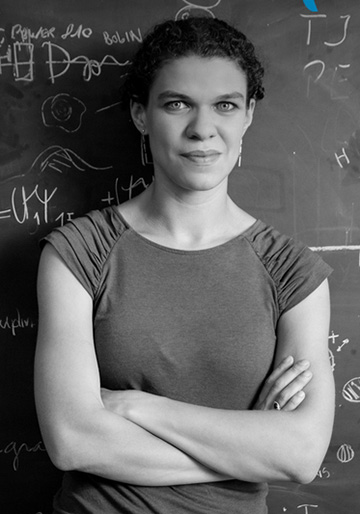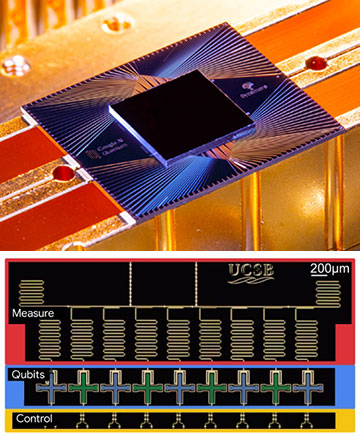![]()
Artist’s rendition of the Sycamore processor mounted in the cryostat. [Image: Forest Stearns, Google AI Quantum Artist in Residence]
In a paper published in the 24 October 2019 Nature, Google created quite a stir in the world of quantum information. In that study, a group of the web behemoth’s scientists, led by physicist John Martinis, reported that its 53-qubit superconducting quantum computer, dubbed Sycamore, had succeeded in carrying out a task that would have been impossible for a classical supercomputer to perform in a reasonable time.
For the keynote address to kick off OSA’s 2020 Quantum 2.0 conference—a brand-new meeting focused on developments in quantum science and technology—a contributor to the Sycamore effort, Marissa Giustina of Google AI Quantum, took the meeting’s online attendees on a whirlwind trip through the process that led to the company’s blockbuster 2019 announcement.
What is a “useful quantum computer”?
Giustina began by noting that Google’s interest in quantum computing, and particularly its relevance to optimization problems, began with the work of computer scientist Hartmut Neven in 2012. That interest quickly expanded in 2014 with the addition of the quantum computing effort of researcher John Martinis at the University of California, Santa Barbara, USA. The project has since mushroomed to a 70-person team, with the application effort centered in Los Angeles, hardware research in Santa Barbara, and the cloud interface—which “has the job of letting us talk to each other”—in Seattle, Washington.

Marissa Giustina. [Image: Google AI Quantum]
As the name implies, building a “useful quantum computer” requires three things, Giustina said. One is, of course, a computer—a machine that performs a computational task. Another is a controllable quantum system, with many quantum bits, or qubits—which means, she added, that “you’re going to have to harness zillions of amplitudes” to control these qubits. And the quantum computer needs to be useful, which Giustina stressed is “not a trivial addition,” requiring sufficiently evolved error correction to take things in the direction of a universal programmable quantum device.
Scoping out a prototype
That goal is something unlikely to be reached anytime soon. So Google’s effort started with a prototype, drawing on the superconducting-circuit flavor of quantum computing being worked on in the Martinis lab. The goal was to try to develop a prototype system that could “enter a space where no classical computer can go” (or, at least, go in a reasonable amount of time). The team’s calculations and reasoning suggested that a size of “around 50 qubits” was the threshold for that computational frontier, and the Sycamore system that the team built in fact sported 53 superconducting qubits.
Those qubits were to be laid out in a 2D-array, to allow the team to track errors by performing parity checks on pairs of qubits. Giustina admits that this rests on the assumption that errors at the system level can be tracked by looking at discrete errors between qubits—something the team would need to test. Making the system “good for something,” she added, needed “a good handshake between algorithm and hardware developers.” (Indeed, Google has developed an open-source Python library, Cirq, to help enable that collaboration.)
The “tricky stuff”: Building the quantum machine

The Google Sycamore chip (top) involves an architecture constructed of control circuitry, superconducting qubits (in aluminum-on-silicon), and microwave resonators for measurement. [Image: Erik Lucero, Google (top); Google AI Quantum (bottom)]
With that as background, Giustina moved on to what she called “the tricky stuff”—how actually to make such a prototype quantum computer. The superconducting microwave qubits themselves were constructed of capacitors and SQUIDs (pairs of Josephson junctions), fashioned in a cleanroom from aluminum-on-silicon in a 2D pattern. Transmission-line LC resonators were added to each qubit, with the resonator length for each qubit slightly different from the others, so that the individual qubits could read out at different microwave frequencies.
Each processor chip thus packages together control, qubit and measurement in a single structure. To make a bigger chip, the team used a 3D integration, cementing 2D arrays together with indium bumps. Then the entire package was put on a dilution refrigerator, which chilled it to a temperature of 20 mK.
Of calibration and music
A major next challenge was calibrating the machine. Giustina drew on a musical metaphor to explain the calibration. “A musical instrument generates a sound that listener hears as a note—but the musician must be good enough to produce that note,” she said. “Similarly, calibration is the process of producing the right electronic wave that will produce the quantum gate that we want. The qubit is our listener, and the control electronics is our instrument.”
Such calibration isn’t trivial, Giustina noted. Indeed, Google has written computer programs to handle it, so that the calibration isn’t limited to one or two qubits. “We need all the qubits to work,” she said. “We can’t just rely on ‘hero’ performance for one or two.” The team also did a battery of input–output test to gauge the system fidelity, assessing the system error by looking at the errors between each qubit and its four nearest neighbors. The result was a readout error of 3.8%. “We’re pretty proud of these error rates,” Giustina said.
Finding the right problem
With the machine built and calibrated, the Google team next needed to find “a small milestone computational task”—something that the Sycamore unit could handle easily, but that would take “too long” for a classical machine to do. “There’s not much difference between a classical computer and an abacus,” Giustina noted. “They can both simulate each other. A quantum computer uses a different kind of computation altogether.”
Ideally, such a demonstration would involve some classic problems on which it’s believed quantum computers would excel, such as factoring of large numbers or function inversion. These are problems that tend to hang up classical computers—but, interestingly, that would be easy to check by running them in the other direction with a classical machine. Unfortunately, though, Giustina said that current quantum hardware is not nearly sophisticated enough to solve these problems.
So the team settled on a specific problem—related to the mapping of quantum logic gates to specific bit strings—that’s known to have high computational complexity. The quantum computer could run the problem directly; a classical computer could solve it only by simulating the quantum machine’s wave function. “We could then determine the classical cost of the quantum machine’s labor,” Giustina said. “If it’s ‘too high’, we have achieved our goal.”
Checking the uncheckable
One problem, of course, is that when the number of qubits becomes large enough for the quantum device to outperform the classical computer, then it’s no longer possible to use the latter machine to check the performance of the former. Giustina walked the audience through the complex verification regime that the team used, which include both modeling of the problem and test runs with simplified circuits that could be checked classically, to amass a picture of the machine’s performance indirectly. The two lines of evidence, she said, mutually reinforced one another and provided significant confidence of the quantum machine’s advantage.
“The take-home message,” according to Giustina, was that “Sycamore can run 53 qubit circuits with nonzero fidelity,” and that achieving the same fidelity on a classical machine would require “a ridiculous amount of resources.” The next big question, she believes, will be to determine whether quantum mechanics, and quantum error correction, can hold for a very large, highly complex system. “For a system of this size, at least, it’s possible,” she said. “But the work done here is the tip of the iceberg. To realize error correction, significant work will be necessary.”
